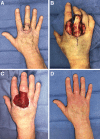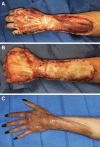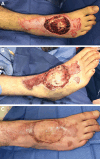Outcomes of Biodegradable Temporizing Matrix for Soft Tissue Reconstruction of the Hand and Extremities
- PMID: 38962155
- PMCID: PMC11221855
- DOI: 10.1097/GOX.0000000000005956
Outcomes of Biodegradable Temporizing Matrix for Soft Tissue Reconstruction of the Hand and Extremities
Abstract
Background: NovoSorb biodegradable temporizing matrix (BTM) is a novel, bilayer, synthetic skin substitute made of biodegradable polyurethane foam covered with a sealing membrane. BTM has demonstrated excellent outcomes in burn literature; however, few studies have been published for hand and extremity soft tissue reconstruction.
Methods: All patients who underwent extremity reconstruction with BTM from 2018 to 2023 were reviewed. Demographics, presentations, and clinical outcomes were recorded.
Results: A total of 86 cases from 54 patients (53.7% pediatric; age range: 0-81 years) were included. Common indications included trauma (36%), infection (18.6%), and malignancy (11.6%). BTM was placed over exposed tendon (38.4%), bone (19%), joints (12.8%), nerves (8.1%), and/or blood vessels (7%). BTM served as temporary wound coverage in 26 cases. Complications included hematoma (8.1%), infection (4.7%), and spontaneous delamination (4.7%). Wound closure was successfully obtained without flap use in 93.3%. Poor BTM take was associated with peripheral vascular disease, hypertension, immunosuppression, and BTM hematoma and infection (<0.05).
Conclusion: This study contributes to the growing body of evidence favoring BTM use in challenging reconstructive cases. Although prospective comparative studies are forthcoming, BTM likely has broad applications in reconstructive surgery.
Copyright © 2024 The Authors. Published by Wolters Kluwer Health, Inc. on behalf of The American Society of Plastic Surgeons.
Conflict of interest statement
Author Shaun D. Mendenhall is an educational consultant for PolyNovo, the manufacturer of NovoSorb BTM. All the other authors have no financial interest to declare in relation to the content of this article.
Figures




References
-
- Ang GC. History of skin transplantation. Clin Dermatol. 2005;23:320–324. - PubMed
-
- Ehrenfried A. Reverdin and other methods of skin-grafting: historical. Boston Med Surg J. 1909;161:911–917.
-
- Freshwater MF, Krizek TJ. Skin grafting of burns: a centennial. A tribute to George David Pollock. J Trauma. 1971;11:862–865. - PubMed
-
- Freshwater MF, Krizek TJ. George David Pollock and the development of skin grafting. Ann Plast Surg. 1978;1:96–102. - PubMed
LinkOut - more resources
Full Text Sources
